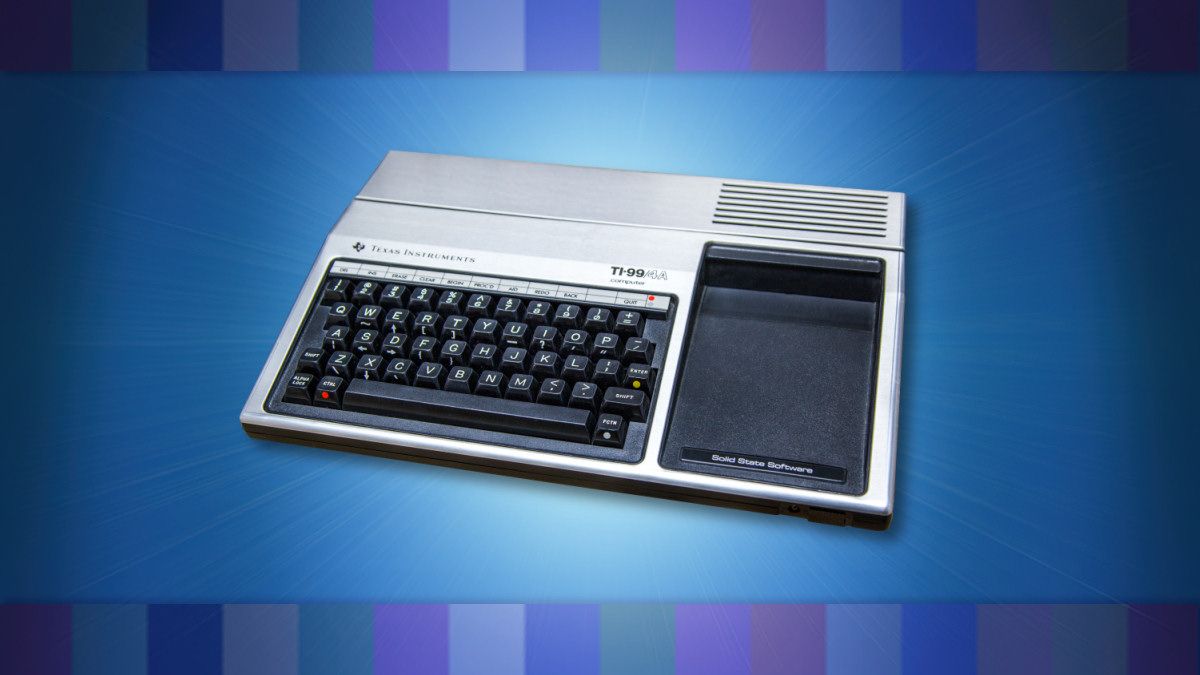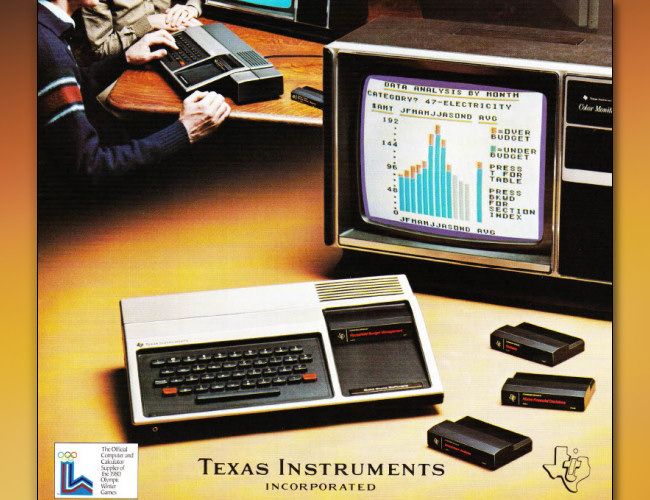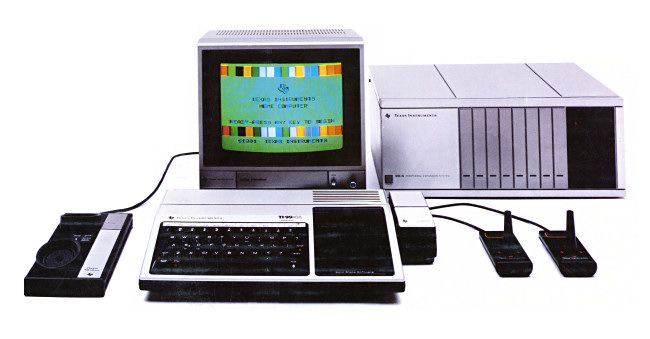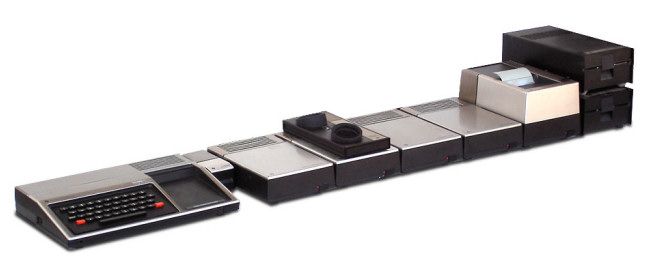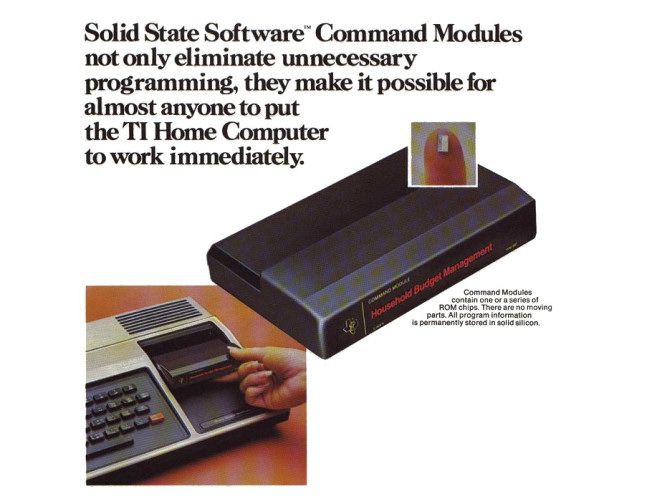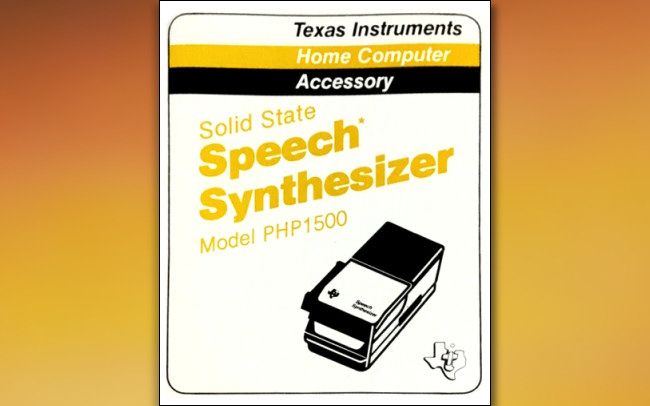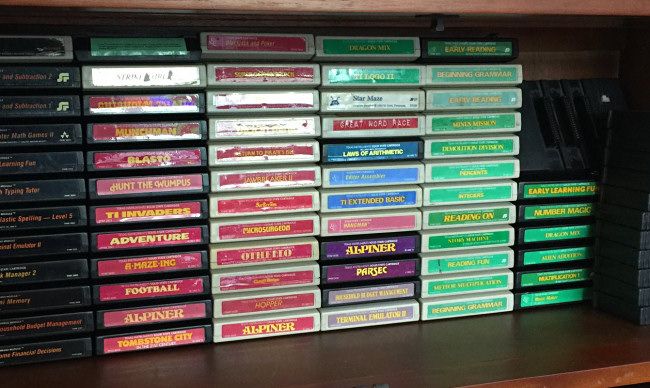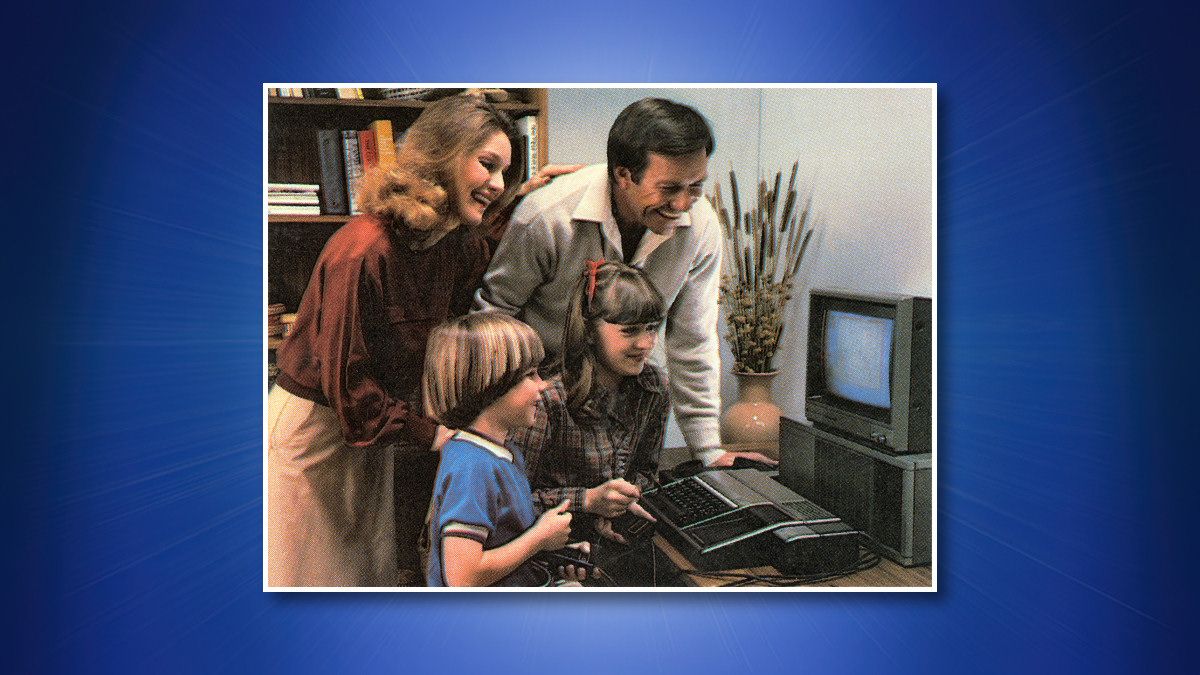Quick Links
In June 1981, Texas Instruments released the TI-99/4A, a 16-bit home computer and gaming platform that became a huge cultural success in America after selling 2.8 million units, although it resulted in a business loss for TI. Forty years later, here's what made it special.
What Came Before: 1979's TI-99/4
After dazzling the world with pocket calculators and digital watches in the early-mid 1970s, Dallas-based electronics powerhouse Texas Instruments set its sights on the emerging video game and personal computer markets in the late 1970s.
At first, the firm intended to create both a video game console and a low-cost personal computer, but while in development, those products merged together into the TI-99/4 (no "A" yet), which was released in late 1979. The 99/4 retailed for $1,150 (about $4,083 today), and due to strict FCC emissions regulations, shipped with its own 13" custom color TV set as a monitor. Notably, the TI-99/4 included the 16-bit TMS9900 CPU, which was based on the TI-990 minicomputer, making it the first mass-market PC with a 16-bit CPU in the U.S.
From the beginning, TI wanted to maintain tight control over who developed software for its 99/4 platform, so the company didn't publish technical specifications or initially release an editor/assembler package that would allow for advanced programming on the system. This locked out third-party developers that could have enriched the platform with software variety.
Due to its limited chiclet-style keyboard, limited application support, and high price due to the pack-in color monitor, the TI-99/4 received poor reviews and flopped in the marketplace. Varying reports say that it sold somewhere between 20,000 and 100,000 units in total.
Enter the TI-99/4A
After the 99/4 flopped in 1980, TI decided to try again. It went back to the drawing board and came up with the TI-99/4A (note the "A" in the name), which included the same 16 KB of RAM and 3 MHz TMS9900 CPU as its predecessor, but which also included a full-stroke keyboard, lowercase support, and graphics chip improvements.
Although the TI-99/4A and its predecessor garnered some criticism for not living up to the potential of its 16-bit CPU, others found its design elegant. "The internal design of the system was excellent and one of the best home computers I had worked on to date," says Scott Adams, who developed several games for the platform with Adventure International.
Unlike the 99/4, the TI-99/4A didn't need to ship with a dedicated color monitor. After the launch of the TI-99/4 in 1979, TI acquired a conditional waiver from the FCC that allowed it to sell home computers that could attach to a standard home TV set. (Eventually, these relaxed rules would be adopted fully in 1983.)
Without the expensive monitor, TI could cut the cost of its revised machine dramatically. The TI-99/4A launched in the U.S. in June of 1981 for $525 (equivalent to about $1,409 in 2021), which was about half the cost of an Apple II at the time. This price put it in the range of other consumer home computers, such as the Commodore VIC-20, TRS-80 Color Computer, and Atari 800, which were some of its main American competitors at the time. As a celebrity pitchman, TI chose actor and comedian Bill Cosby.
The TI-99/4A included built-in TI BASIC programming language, and it shipped with nice manuals that taught computer novices (especially kids) basic programming concepts. For inexpensive data storage, you could buy a special cable that let you save or load programs with a standard cassette tape recorder.
Expansion on the TI-99/4A was a little weird. TI initially released several different "sidecar" modules for the 99/4 that plugged into a port on the right side of the computer. These modules included a disk drive controller, a 32K RAM expansion, an RS-232 interface, a speech synthesizer, and even a printer. If you plugged them all in at once, you got an ungainly peripheral train that barely fit on a desk.
To solve that problem, TI later released the Peripheral Expansion System. It included a disk drive and several of the sidecar modules as plug-in cards in a heavy external chassis. But few bought it due to its relatively high cost of $1,475 (about $4,700 today).
What Was Cool About the TI-99/4A?
Texas Instruments went to great lengths to make the TI-99/4A a user-friendly machine, and the TI-99/4A included several features that made it fun to use. Here are just a few of them.
Software Applications on Cartridge
Like other home computers of the time, the TI-99/4A could play computer games that shipped on ROM cartridges (TI called them "Command Modules.") like a video game console. But Texas Instruments also went out of its way to publish serious software applications, such as word processors, financial utilities, terminal emulators, and more on cartridge, which made loading and using the apps far easier and quicker than using a disk drive or cassette recorder.
TI called this approach "Solid State Software," which emphasized the fact that users could instantly load applications stored on silicon chips with no moving parts.
The Speech Synthesizer
In 1978, Texas Instruments released the Speak & Spell educational toy, which included breakthrough speech synthesis technology developed at TI. In 1980, TI included that same tech in a small box that plugged into a port on the right side of the TI-99/4 (and later, the 4A). The Speech Synthesizer module added impressive spoken sound effects to video games, such as Alpiner, Parsec, and others. You could also program your own speech output in BASIC. It felt very futuristic at the time.
Great Video Games
When it came to gaming, the TI-99/4A played host to its share of computer gaming classics. Popular favorites include Parsec (a side-scrolling space shooter), Alpiner (You climb up mountains.), TI Invaders (think Space Invaders), Munchman (a Pac-Man clone), Hunt the Wumpus (a puzzle game), and later, a selection of competent Atarisoft ports of arcade games like Donkey Kong and Centipede.
In particular, a 1983 adventure game called Return to Pirate's Isle stood out as a technical achievement. Developer Scott Adams, a pioneer known for creating adventure games for early PCs, crafted a novel system to display graphics in the game that could fit in the limited space available on a cartridge.
"I came up with what was a system that allowed decent cell drawn pictures but was fairly labor-intensive for the graphical artist," says Adams. "We had a palette of shapes the artist could use to make all the pictures. He could add as needed to the selection, but we had to try and keep the size of this palette small."
The 99/4A also supported over 40 educational games (that covered math, geography, language, and more) published on cartridge---far more than was typical for other computer platforms.
A Unified Interface
TI made navigating the 99/4A interface easy with onscreen menus and function keys. At boot, you'd see a splash screen, and then a numbered menu, with choices based on what was plugged into your cartridge slot. To start TI BASIC, you'd press "1" on the keyboard. To start other programs on cartridge, you'd press "2" or higher.
Also, the TI-99/4A included a Function key on its keyboard that allowed you to use its number keys as function interface keys. Many software applications used these standardized keys (such as "Redo," "Back," and "Quit") for navigation through onscreen menus. It was a user-friendly touch for the time.
Business Failure, Cultural Success
Initially, the TI-99/4A sold well, but after intense price competition from Commodore, it fell behind. TI introduced a $100 rebate in September of 1982 that briefly put it back in first place, with roughly 35% of the home computer market in the U.S.
At the height of the competition, TI suffered an additional financial setback. In early 1983, engineers at TI discovered a potential electrical shock hazard with its power transformer, and the firm issued a recall and offered a safety adapter cord to customers at a cost of $50 million.
As the destructive price war with Commodore intensified, TI continued to drop prices until it began selling the TI-99/4A at a loss for under $100 in mid-1983 (even with a new, cost-reduced, beige-colored model). After writing off multiple hundred-million-dollar losses from poor sales and overproduction, Texas Instruments pulled the plug on manufacturing the TI-99/4A in October of 1983. After that, the price of the TI-99/4A dropped to $50 (and in some cases, as low as $20) as the firm cleared inventory.
While the Commodore/Atari/TI home computer price war destroyed the sub-$1,000 home computer market and tanked the video game industry with it, customers took advantage of the low prices. The TI-99/4A sold around 2.8 million units in total, giving it a sizeable cultural footprint in American technological lore.
So today, you'll see a different angle taken on the TI-99/4A's history depending on who is telling the story. From a business point of view, the 99/4 series represented a significant market blunder for TI, resulting in significant losses and a short product lifespan of just over two years. But from a cultural standpoint, the TI-99/4A was a resounding success, inspiring and entertaining a generation of kids who grew up to architect our modern technological world.
As with any historical tale, the shape of the story depends on how you slice the cake. Happy birthday, TI-99/4A!

